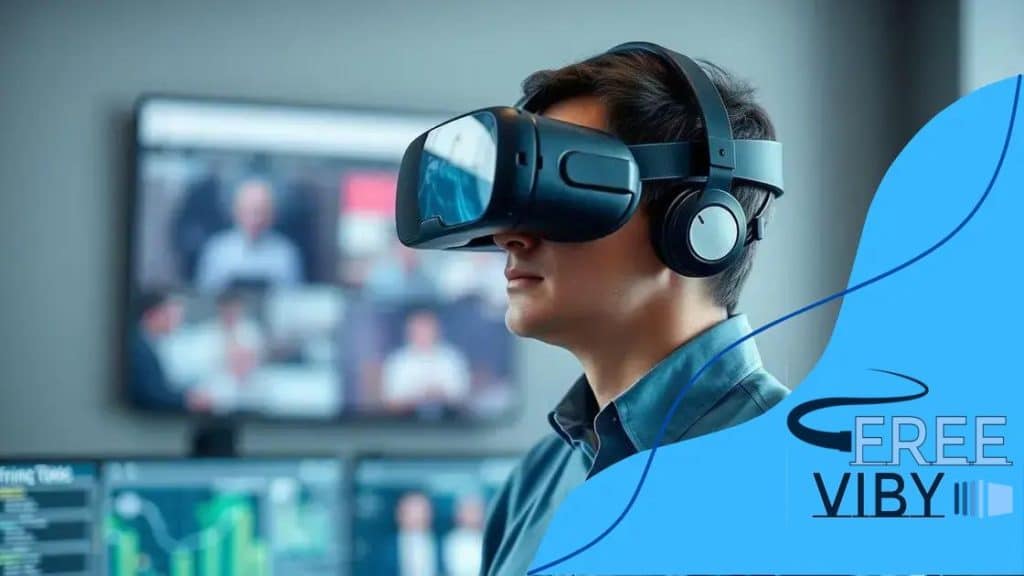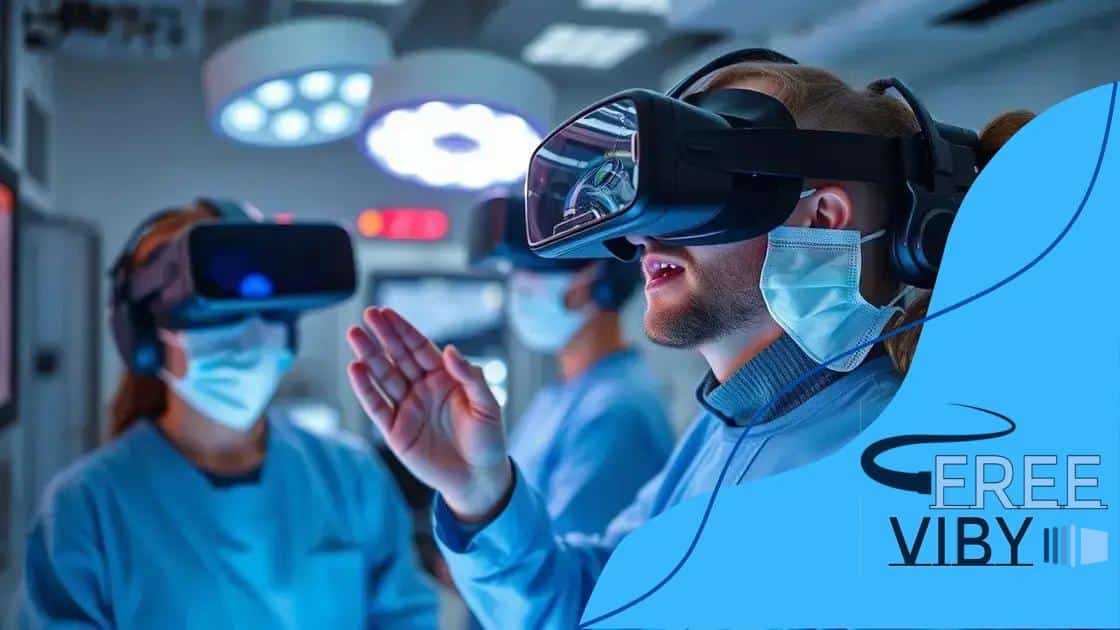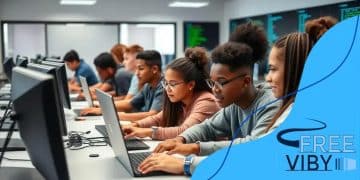Virtual reality is enhancing career training opportunities

Anúncios
Virtual reality is enhancing career training by providing immersive, personalized learning experiences that improve skill acquisition and engagement while reducing risks associated with traditional training methods.
How virtual reality is enhancing career training opens up exciting possibilities for skill development. Imagine walking into a virtual world where you can practice your profession without the pressure of real-life consequences.
Anúncios
Intrigued? Let’s dive into the transformative effects of VR on training.
Understanding virtual reality in career training
Understanding virtual reality in career training is essential for exploring how technology can reshape skill development. Virtual reality creates immersive environments where learners can practice real-world scenarios.
Virtual reality is enhancing career training opportunities by creating dynamic, interactive spaces for skill-building. VR headsets transport learners into simulated environments, allowing them to practice real-world tasks safely.
This approach fosters confidence and competence, redefining traditional training methods.
Anúncios
What is virtual reality?
Virtual reality (VR) immerses users in a digital realm via specialized headsets, mimicking real-life scenarios. Unlike traditional methods, VR offers hands-on practice without physical risks, making it ideal for mastering complex skills.
VR simulates environments with stunning realism, from operating rooms to flight cockpits. This technology ensures trainees gain practical experience in a controlled setting, boosting retention and readiness.
By blending interactivity with immersion, VR transforms learning into an engaging adventure. Trainees can explore, experiment, and refine skills in ways that static methods can’t match.
Benefits of VR in career training
Virtual reality is enhancing career training opportunities through unparalleled engagement. Interactive simulations captivate learners, turning training into an enjoyable, memorable experience that drives motivation.
VR provides a safe space to practice high-stakes tasks without real-world consequences. Trainees can experiment, fail, and learn, building confidence in fields like medicine or engineering.
Instant feedback and accessible platforms further enhance VR’s appeal. Real-time critiques help refine skills, while remote access ensures training reaches diverse learners globally.

Key benefits of VR for skill acquisition
The key benefits of virtual reality for skill acquisition are transforming the way individuals learn and develop new abilities. By creating immersive learning environments, VR offers unique advantages that traditional training methods cannot provide.
Virtual reality is enhancing career training opportunities by revolutionizing skill development. Immersive environments offer unique advantages, enabling learners to master abilities with precision and confidence.
From dynamic engagement to tailored scenarios, VR redefines how professionals grow.
Enhanced engagement
VR’s immersive simulations captivate trainees, making learning a thrilling experience. By interacting with lifelike scenarios, users stay focused and retain knowledge more effectively than through traditional methods.
This heightened engagement suits diverse industries, from healthcare to hospitality. Trainees remain invested, as VR transforms mundane lessons into interactive challenges that spark curiosity.
Engaging VR experiences also boost motivation, encouraging learners to explore complex tasks. This dynamic approach ensures skills stick, preparing professionals for real-world demands.
Safe practice environment
Virtual reality is enhancing career training opportunities by offering risk-free practice spaces. Trainees can tackle high-pressure scenarios, like emergency response, without real-world consequences, fostering bold experimentation.
These safe environments allow endless repetition, reinforcing mastery of critical skills. From aviation to manufacturing, VR ensures trainees refine techniques in secure, controlled settings.
Instant feedback within VR simulations accelerates learning. Trainees correct errors in real time, ensuring skills are honed efficiently and effectively for professional success.
Real-world applications of VR in various industries
The real-world applications of virtual reality in various industries are expanding rapidly. From healthcare to engineering, VR is changing the way professionals work and learn.
Virtual reality is enhancing career training opportunities across diverse sectors, from medicine to manufacturing. By integrating immersive simulations, industries are revolutionizing how professionals prepare for real-world challenges.
VR’s versatility ensures safer, smarter, and more engaging training.
Healthcare
In healthcare, VR empowers medical professionals to practice intricate surgeries in simulated environments. These risk-free settings enhance precision and confidence, ensuring better patient outcomes.
Trainees can explore virtual operating rooms, mastering techniques without endangering lives. This immersive practice bridges the gap between theory and real-world application.
VR also supports ongoing training, keeping healthcare workers updated on new procedures. Its realistic scenarios ensure readiness for high-stakes medical challenges.
Aerospace and aviation
Virtual reality is enhancing career training opportunities for pilots through lifelike flight simulations. Trainees navigate challenging conditions, from storms to system failures, without leaving the ground.
VR cockpits familiarize pilots with complex controls, boosting confidence and competence. These simulations replicate real aircraft, ensuring seamless transitions to actual flights.
Emergency protocols become second nature as pilots practice in controlled VR settings. This preparation enhances safety and performance in critical situations.
Manufacturing
In manufacturing, VR trains workers to operate complex machinery safely. Virtual scenarios reduce workplace accidents by allowing employees to master equipment in risk-free environments.
Designers use VR to visualize 3D prototypes, streamlining product development. This saves time and resources, ensuring high-quality outputs before physical production begins.
VR also enhances efficiency by simulating assembly lines. Workers refine processes virtually, boosting productivity and safety on the factory floor.
Education and training
Virtual reality is enhancing career training opportunities in education by immersing students in interactive learning. From exploring historical events to dissecting virtual organisms, VR deepens understanding.
Corporate training leverages VR to sharpen soft skills like communication. Employees practice realistic scenarios, improving teamwork and client interactions in safe settings.
This immersive approach boosts retention and engagement across disciplines. VR transforms traditional education into a dynamic, hands-on experience for all learners.
Challenges in implementing VR training
While virtual reality is enhancing career training opportunities, its adoption faces hurdles.
From costs to user comfort, these challenges require strategic solutions to unlock VR’s full potential. Addressing them ensures effective, inclusive training programs.
Cost considerations
High initial costs for VR hardware and software can deter smaller organizations. Developing tailored training content further escalates expenses, posing barriers to widespread adoption.
However, long-term benefits, like reduced training errors, often outweigh upfront investments. Scalable solutions are emerging, making VR more accessible to diverse businesses.
Strategic budgeting and partnerships can mitigate costs. Companies prioritizing VR see significant returns through enhanced workforce skills and efficiency.
Technical limitations
VR systems can be complex, requiring technical expertise for setup and maintenance. Compatibility issues with existing platforms may hinder seamless integration.
User-friendly interfaces and robust support systems are critical for success. Advances in VR technology are steadily reducing these technical barriers.
Organizations must invest in training staff to manage VR systems effectively. This ensures smooth implementation and maximizes training outcomes.
User acceptance
Some trainees experience motion sickness or discomfort with VR, slowing adoption. Unfamiliarity with the technology can also create resistance among users.
Clear onboarding and gradual exposure help ease users into VR environments. Supportive training programs build confidence and reduce anxieties.
Customized experiences tailored to individual comfort levels enhance acceptance. This ensures VR training is inclusive and effective for all learners.
The future of career training with virtual reality
Virtual reality is enhancing career training opportunities by paving the way for innovative, accessible learning.
As technology evolves, VR promises to redefine how professionals prepare for dynamic careers. The future holds exciting possibilities for immersive skill development.
Personalized learning experiences
VR enables tailored training paths, adapting to individual learning paces and styles. This customization ensures optimal skill retention and practical application for every trainee.
From medical diagnostics to customer service, VR scenarios align with specific needs. Trainees progress confidently, mastering skills relevant to their roles.
As VR platforms advance, personalization will become even more precise. This ensures training remains engaging, effective, and aligned with career goals.
Integration of Artificial Intelligence
Improved collaboration
Collaborative training environments will be another key aspect of the future of VR training. With multi-user capabilities, employees from different locations can train together in a virtual setting.
As we look ahead, the incorporation of virtual reality in career training promises to create more engaging, effective, and efficient learning pathways. This innovative technology will allow students and employees to prepare better for real-world challenges.
Virtual reality is reshaping the landscape of career training. Its ability to create immersive and personalized learning experiences enhances skill acquisition while making training more engaging.
By integrating AI and promoting collaboration, VR prepares trainees for real-world challenges. As industries continue to adopt this technology, the future of career training looks bright and full of possibilities.
FAQ – Frequently Asked Questions about Virtual Reality in Career Training
What are the main benefits of using virtual reality for career training?
Virtual reality enhances engagement, provides a safe practice environment, and allows for personalized learning experiences that adapt to individual needs.
How does virtual reality improve skill acquisition?
VR offers immersive training scenarios that enable users to practice skills without real-world consequences, enhancing their confidence and competence.
What challenges are associated with implementing VR training?
Challenges include high initial costs, technical limitations, and the need for user acceptance to ensure effective training.
What does the future hold for VR in training?
The future of VR in training looks promising, with increased adoption across various industries, improved collaboration, and integration of AI for personalized experiences.






